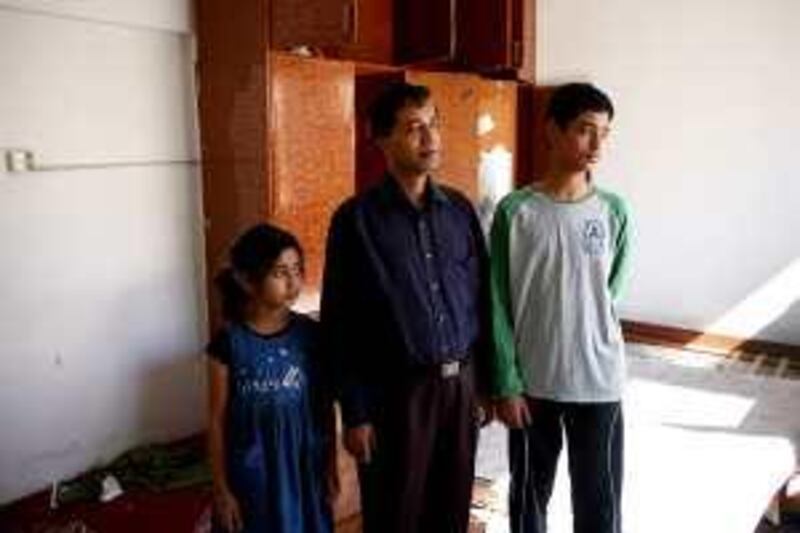ABU DHABI // Even after wrecking crews ripped the banisters from the stairwell and hemmed in the property with demolition boards late last year, the eight families living in the Manasir villa resisted eviction.
When the landlord disconnected their water and electricity, Qazi Ahmad's daughter studied for her high-school exams by candlelight. Across the hall, Abdul Bari's family ate takeaway meals in the dark. Downstairs, Gulzar Hossain's children fetched their bathwater daily from the neighbourhood mosque. By the time the last tenants vacated, on February 28, they had managed to delay the demolition of their units by three months while struggling to find comparably comfortable and cheap accommodations.
"Where else to go? Abu Dhabi rents are too high," said Mr Hossain, an Indian perfume salesman who lived on the ground floor for a decade. "We left so quickly and there were many things I left in that old building. My children's toys are there, many things. Believe me, my heart is there." An expected rise in demolitions could exacerbate the problem. With more residents being forced out of crumbling but low-rent buildings, affordable housing in the capital could soon bite the dust.
The number of demolition permits issued by Abu Dhabi Municipality's town planning section rose to 282 last year from 162 in 2007, an increase of more than 74 per cent. The municipality said last week it expected the number of demolition projects to continue rising over the next few years as the capital undergoes a major urban revitalisation. Additionally, a quarter of the 1,000-plus construction projects entrusted to Abu Dhabi Commercial Properties (ADCP) require an existing building to be rased, said Denis O'Connor, the chief executive of the division that manages most of the emirate's housing stock.
Given the ages of the buildings now overseen by ADCP, he said, "it's likely that this percentage will remain constant for the foreseeable future". He also noted a prevalence of "severely dilapidated" buildings in certain areas. The major social challenge to arise from the consistent demolitions would be how to provide affordable housing in a time of high construction costs and a continuing shortage of supply, said Mr O'Connor.
"Older buildings will be occupied at rental rates which are way below current market, leading to a resistance on the part of tenants to vacate." In Mr Hossain's case, his family's rent at the three-storey villa in Manasir had doubled to Dh2,500 (US$680) a month from Dh1,250 a few years ago. The owner of the building notified the occupants last October that the building would be knocked down. "The place itself was cracked. It wasn't safe. It wasn't a proper place to stay," the owner said last week.
The occupants offered to pay more rent - up to Dh3,500 per month - but the owner wanted a modern high-rise on the land to replace the 35-year-old villa. The average lifespan of a building in the UAE is 15 to 30 years, due to the harsh climate and humidity, according to the demolition contractors MTKA and Zaarour Trading. Saqer Hamdan, the co-owner of MTKA in Abu Dhabi, estimated that as many as 30 per cent of all buildings in the emirate were either too old or decaying rapidly.
"About 20 to 30 per cent will be demolished in the next two or three years, especially in an area like Nadisiya," Mr Hamdan said. "There, [buildings are] very old. You'll see cracks, no central air systems. They don't have firefighting systems." Facing eviction late last year, the eight families squatting in the Manasir villa appealed to the Abu Dhabi Committee for Settlement of Rent Disputes to get their electricity and water lines restored, agreeing to leave on January 31. They carried on living there through February, even after the electricity and water were disconnected.
Like many of his former neighbours, Mr Bari now shares a flat with another family and pays Dh2,500 a month for the privilege. Residents in a condemned building in the Tourist Club area credited the rental disputes committee for tossing them several lifelines. The building, slated for demolition by the Al Harif contracting company, has seen its demolition stalled for more than a year, according to the residents.
Several, such as Mouzi Ysak, 28, from Ethiopia, said they were staying put because rents elsewhere in the city were too high. "It's very difficult to live in Abu Dhabi," the pharmacy stocker said. "The rent here is cheap." New tenants, such as Rash-Milan Mohamed, were still filling vacancies last week. "I knew this place was scheduled to be demolished and it could still happen," said Mr Mohamed, who has moved 10 times within four years due to evictions for demolitions as well as rent hikes he could not afford.
Only about 10 families are believed to still occupy units in the eight-storey apartment, which has had most of its air-conditioning units and windows removed and most of its flats deserted. Several fire extinguishers inside are also out of pressure. Even so, Mr Mohamed was not concerned, so long as he had a home. "I don't want to shift again, so I'm just hoping the court order will extend this demolition and this building will stand," he said. "Otherwise, who knows, it might just be dust in a couple of months."
mkwong@thenational.ae






